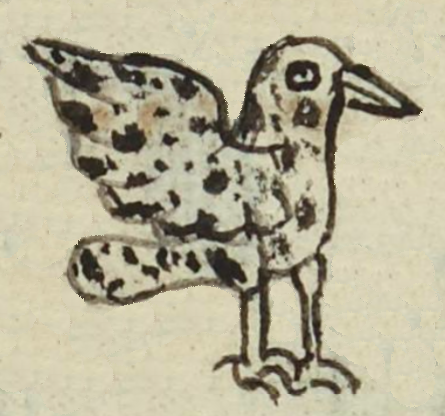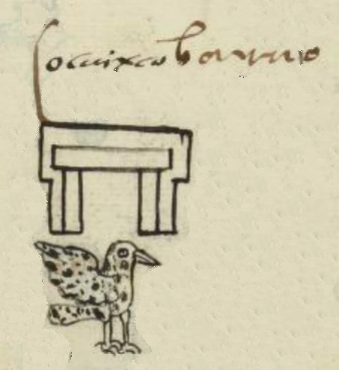Oncuixco (MH624v)
This black-line drawing for the simplex glyph for the place name Oncuixco shows a spotted bird of prey (a cuixtli) with its wings raised as though about to take flight. It is shown in profile, facing toward the viewer's right. The locative suffix -co (on or at) is not shown visually.
Stephanie Wood
The starting letter O-, attached to a noun as it is here, usually means "two," and should more properly be On-, so we have inserted an "n." Perhaps this is not necessary. Ocuixtli is a near homophone with oquichtli, man, but we are staying with the interpretation that points to a place known for "Two Kites" or "Two Birds of Prey," given both the visual elements and the gloss that uses "c" rather than "q." Note the glyph for a person from Oncuixtli, below, which emphasizes the black-and-white feather that seems fitting when compared to the bird in this place name glyph, which is also black and white. Furthermore, the notation for two is notable in the Oncuixcatl glyph, which helps underscore the possibility here.
Stephanie Wood
ocuixco
Ocuixco or Oncuixco
Stephanie Wood
1560
Jeff Haskett-Wood
nombres de lugares, ave, aves, pájaro, pájaros, pluma, plumas, animals, animales

cuix(tli), a kite (bird of prey), https://nahuatl.wired-humanities.org/content/cuixtli
-co, (locative suffix), in or at, https://nahuatl.wired-humanities.org/content/co
ome, two, https://nahuatl.wired-humanities.org/content/ome
o-, two (can be o-, on-, or om-), https://nahuatl.wired-humanities.org/content/o-2
En [el lugar de] Hombres
Stephanie Wood
Matrícula de Huexotzinco, folio 624v, World Digital Library, https://www.loc.gov/resource/gdcwdl.wdl_15282/?sp=331st=image.
This manuscript is hosted by the Library of Congress and the World Digital Library; used here with the Creative Commons, “Attribution-NonCommercial-ShareAlike 3.0 License” (CC-BY-NC-SAq 3.0).






